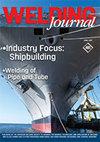Diffusion Welding for TC4 Titanium Alloy/T2 Copper with Vanadium Foil
IF 1.4
3区 材料科学
Q2 METALLURGY & METALLURGICAL ENGINEERING
引用次数: 0
Abstract
TC4 titanium alloy (TC4) was vacuum diffusion welded to T2 copper (T2) with vanadium (V) foil as an interlayer. The influence of process parameters on elemental diffusion behavior, microstructure evolution, and shear performance of welded joints was explored. An obvious solid-solution diffusion zone appeared in the welded interface between TC4 and V, but no distinct diffusion zone formed in the joint interface of V/T2. The solid-solution phases of (Ti6, V)ss, (Ti3, V)ss, and (Ti, V7)ss appeared in the interface of TC4/V. The crystallographic orientations of (Ti6, V)ss, (Ti3, V)ss, and (Ti, V7)ss phases in high-resolution transmission electron microscope images were (002), (201), and (121), respectively. The lattice mismatch between (Ti6, V)ss and (Ti3, V)ss was calculated to be 11.9%. The activation energy to form a stable solid solution between titanium and vanadium was 226.6 kJ/mol. The highest shear strength of the welded joint reached 160 MPa, obtained at 860°C (1580°F) for 60 min. The joint fractured along the interface of V/T2, illustrating that the solid-solution structure between Ti and V was stronger than the metallurgical bonding between V and Cu. The fracture surface of the welded joints revealed a river pattern and ladder topography, representing a cleavage fracture mode. FCC-Cu, BCC-V, and β-Ti were detected on both fracture surfaces of the TC4 titanium alloy and T2 pure copper sides. The influence of welding temperature on the diffusion of V in Ti was greater than on Ti in V, and Ti and Cu diffused faster than V in the joint.TC4钛合金/T2铜与钒箔的扩散焊接
将TC4钛合金(TC4)真空扩散焊至T2铜(T2)上,中间层为钒(V)箔。探讨了工艺参数对焊接接头元素扩散行为、微观组织演变及剪切性能的影响。TC4与V的焊接界面出现了明显的固溶扩散区,而V/T2的接合界面没有形成明显的扩散区。TC4/V界面出现(Ti6, V)ss、(Ti3, V)ss和(Ti, V7)ss的固溶相。(Ti6, V)ss、(Ti3, V)ss和(Ti, V7)ss相在高分辨率透射电镜图像中的晶体取向分别为(002)、(201)和(121)。计算得出(Ti6, V)ss与(Ti3, V)ss的晶格失配为11.9%。钛钒之间形成稳定固溶体的活化能为226.6 kJ/mol。焊接接头在860℃(1580°F)保温60 min时抗剪强度最高,达到160 MPa。接头沿V/T2界面断裂,说明Ti与V之间的固溶组织强于V与Cu之间的金相结合。焊接接头断口呈河流状和阶梯状形貌,为解理断裂模式。TC4钛合金断口侧和T2纯铜断口侧均检测到FCC-Cu、BCC-V和β-Ti。焊接温度对V在Ti中的扩散的影响大于对Ti在V中的扩散的影响,且Ti和Cu在接头中的扩散速度快于V。
本文章由计算机程序翻译,如有差异,请以英文原文为准。
求助全文
约1分钟内获得全文
求助全文
来源期刊

Welding Journal
工程技术-冶金工程
CiteScore
3.00
自引率
0.00%
发文量
23
审稿时长
3 months
期刊介绍:
The Welding Journal has been published continually since 1922 — an unmatched link to all issues and advancements concerning metal fabrication and construction.
Each month the Welding Journal delivers news of the welding and metal fabricating industry. Stay informed on the latest products, trends, technology and events via in-depth articles, full-color photos and illustrations, and timely, cost-saving advice. Also featured are articles and supplements on related activities, such as testing and inspection, maintenance and repair, design, training, personal safety, and brazing and soldering.
 求助内容:
求助内容: 应助结果提醒方式:
应助结果提醒方式:


